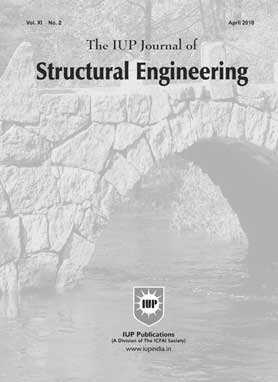
July' 23
The IUP Journal of Structural Engineering
Focus
The analysis was done to determine seismic response values such as peak base shear, peak displacement and peak interstory drift ratio. Further, modal analysis was done. The results show that coupled irregular building models yield peak base shear response in both principal directions under unidirectional seismic force unlike regular building. Modal analysis results indicate coupled irregularities in building models yield coupled contribution of transnational and rotational degrees of freedom in fundamental modes of vibration. Coupled irregular models show amplified peak displacement and peak interstory drift ratio at each floor as compared to regular building models. The authors conclude that coupled irregularity in building models yield seismic amplification in various seismic response parameters, thus making them seismic vulnerable.
The second paper is "Seismic Fragility Estimates of Regular and Irregular Structures with Different Soil Conditions Using Time History Analysis" by Ramesh B M,
K Manjunatha and Ravikumar C M. Here an attempt has been made to analyze regular and vertically irregular structures using time history analysis approach to establish seismic fragility.
The study highlights the importance of obtaining the performance of buildings in terms of operational phase, immediate occupancy, damage control, life safety and collapse prevention. A graph of seismic intensity measurement versus likelihood of a seismic damage condition is called a fragility curve. With such curves, estimation of likely damage occurrence in the buildings can be found. Several models of the regular and irregular buildings have been considered for the analysis.
The time history analysis has considered three Indian Strong Ground Motion records under different soil conditions. Time history analysis is a nonlinear dynamic analysis that uses the finite element approach or direct integration. It takes a minimum of three sets of ground motions to complete a time history analysis. The data obtained has been plotted for comparison. The soil conditions are represented by the use of hard, medium and soft springs to represent different soil conditions.
The analysis reveals that a building founded on soft soil has the largest time period, and as soil gets stiffer, the time period becomes less and less. Irregular buildings show more story displacements as compared to regular buildings for all soil conditions. The fragility curves have been plotted for the regular and irregular buildings under various peak ground acceleration conditions. The fragility condition curves show the level of damages which a building will undergo in a particular condition.
The results indicate that the soil conditions play an important role in the performance of structures. Time period for a regular building is larger than the irregular building. Geometrically, irregular buildings will have more story displacements than a regular building. Spectral accelerations has the highest peak values for fixed base case in all building models considered. Irregular buildings are more vulnerable to suffer damages during seismic excitation.
Editor-in-Chief
Seismic Analysis of Reinforced Concrete Buildings with Coupled Irregularities
Reinforced Concrete (RC) buildings with irregularities, plan and vertical, are susceptible to seismic damage. Such buildings are constructed due to functional, space and aesthetic considerations. Most practical irregular RC buildings have coupled irregularities: plan or vertical or mixed. The seismic behavior of coupled irregular RC buildings is an active area of research. In the present paper, five RC building models with coupled reentrant corners and vertical geometric irregularities are developed along with the regular RC building model. L-shaped and stepped-shaped reentrant corners type plan irregularity is coupled with vertical geometric irregularity by changing plan dimension at each floor level of RC building models. Building models are analyzed for seismic forces following the Indian seismic design code. Seismic parameters-peak base shear, peak displacement, peak interstory drift ratio, modal analysis, normalized base shear and normalized overturning moment-are extracted. It is found that peak displacement and peak interstory drift ratio of coupled irregular building models shows a substantial increase vis-a-vis regular building models. Normalized base shear and normalized overturning moment increase for all coupled irregular building models, except building model BM-3, as compared to the regular building model.
Seismic Fragility Estimates of Regular and Irregular Structures with Different Soil Conditions Using Time History Analysis
Over the years, in the study of earthquakes, there has been a shift in the use of current force-based methodology to performance-based methodology. In this study, an attempt has been made to study the seismic performance of regular and vertically irregular structures by making use of time history analysis to establish seismic fragility estimates. To perform the analysis, three Indian strong ground motions have been considered by varying soil conditions. Comparison has been made in terms of displacement and spectral accelerations for both regular and irregular structures with different soil conditions. The study highlights the importance of obtaining performances in terms of Operational Phase (OP), Immediate Occupancy (IO), Damage Control (DC), Life Safety (LS), and Collapse Prevention (CP). The seismic vulnerability of buildings has been obtained treating the foundation as isolated footing in terms of damages by taking strong ground motion data into consideration to perform performance-based analysis of structures with different soil conditions.